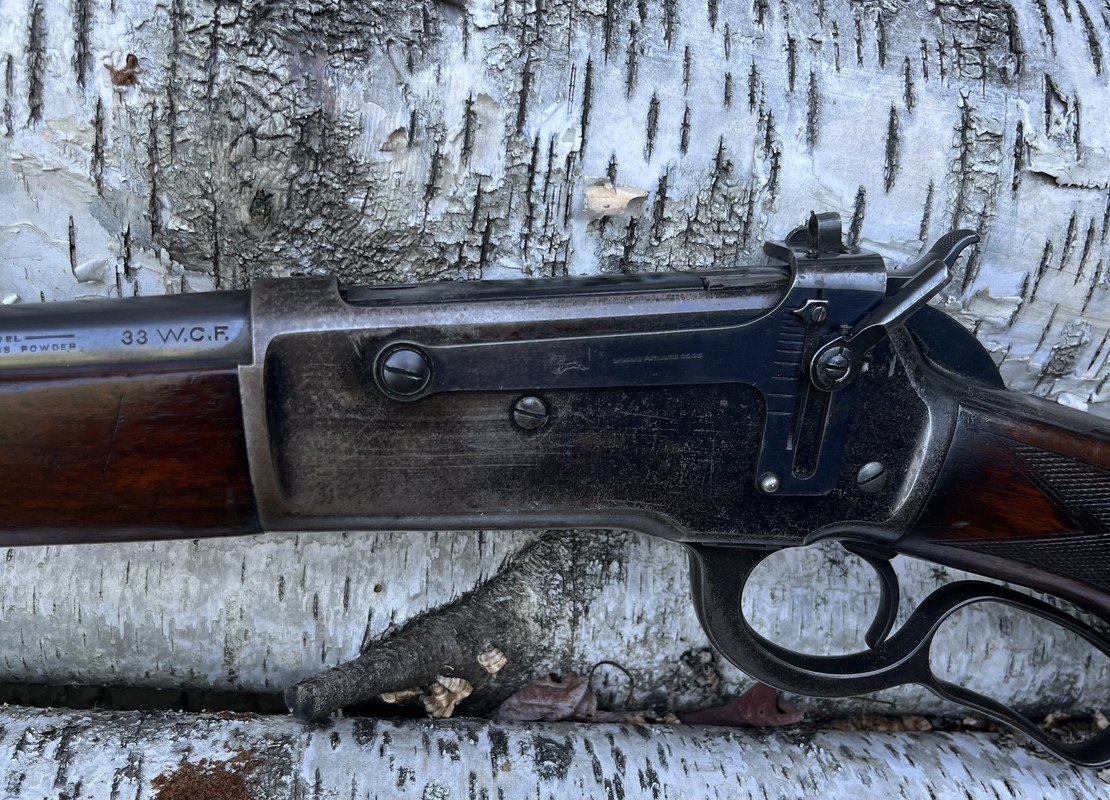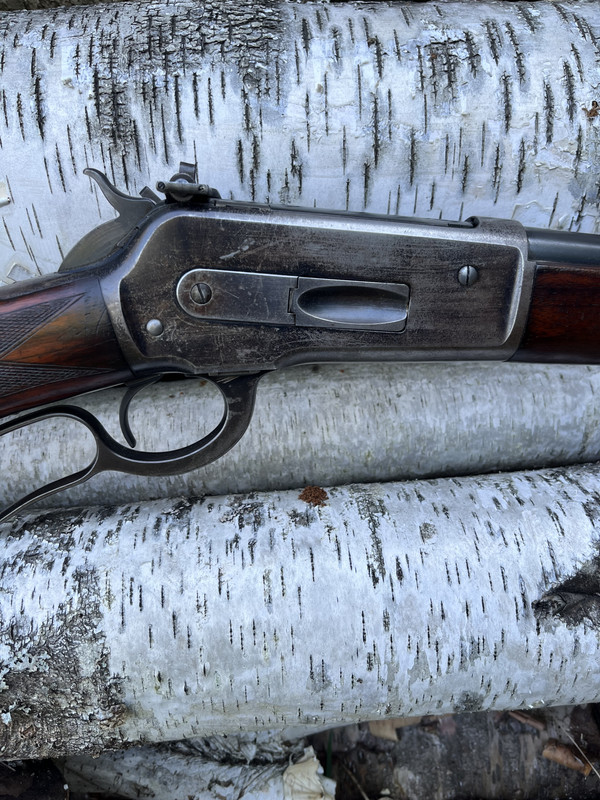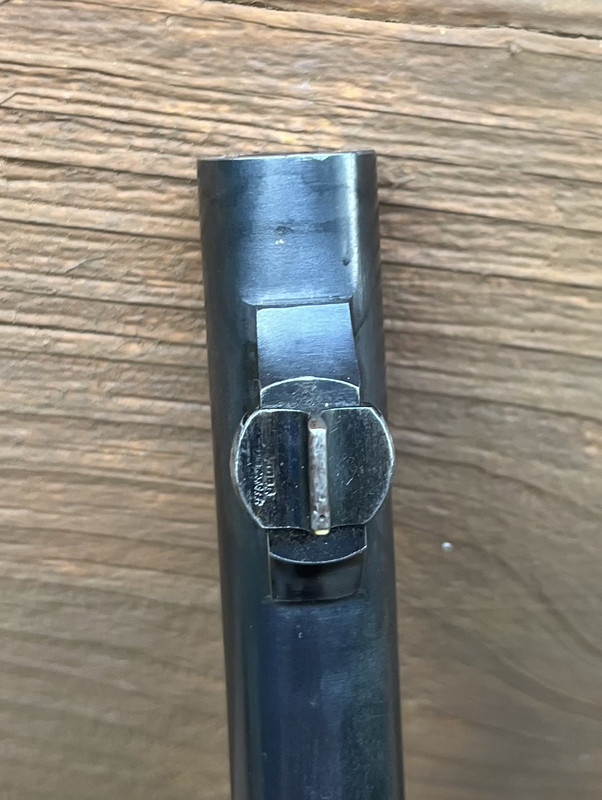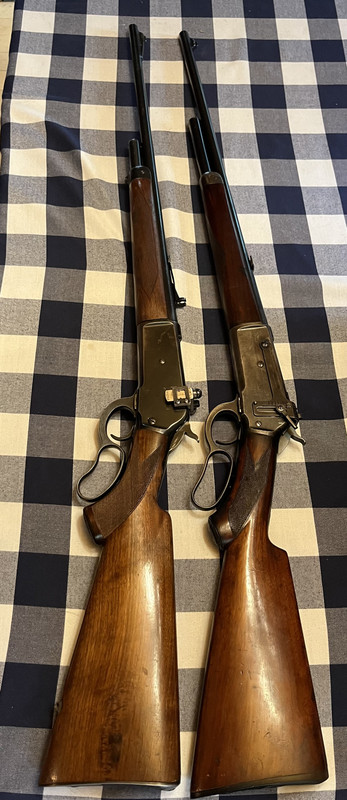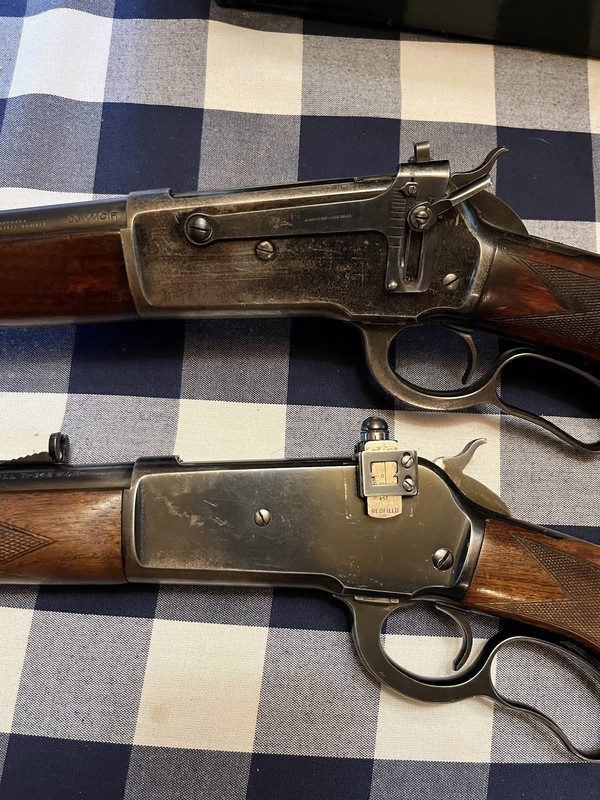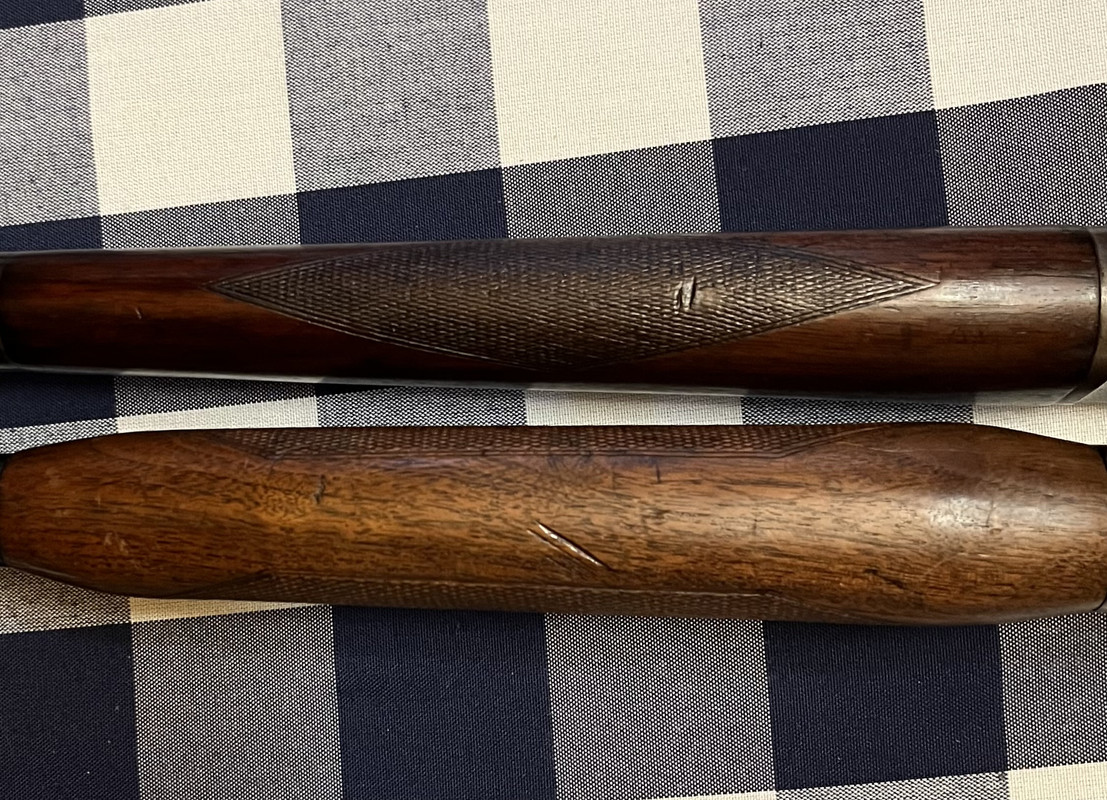September 21, 2016
 Offline
OfflineWinchester 1886 chambered in 33 w.c.f.
1902 DOM I do believe
Lyman sights at the front and rear of the barrel and on the receiver.
24” barrel
2/3? mag
Shotgun butt
Plain grade semi-deluxe stock.
Nickel steel barrel
Bore/rifling is a 9.5 out of 10
Certainly not mint/collector quality, but I’m always pleased with earlier guns having this type of condition and wear. Not bad for a 120+ year old rifle that clearly wasn’t sat in a closet for life.
Serial number: 128,494
She needs a thorough cleaning.
April 15, 2005
 Offline
OfflineThe serial number indicates October 1903 based on several other rifles with CFM letters in that same serial range. If you get a letter for it from the CFM, I would be interested in learning what the actual DOM is.
It is a very nice looking “semi-deluxe” rifle 
Bert
WACA Historian & Board of Director Member #6571L

September 22, 2011
 Offline
OfflineI might be wrong, but the firearm does not strike me as typical of the Model 1886 (uniform) and is beefier and tapered, like the Model 71. Also, the checkering pattern doesn’t seen typical of the Model 1886. Special order or a Model 71 replacement? The latter seems more likely, but never say never with regards to Winchester.
September 21, 2016
 Offline
OfflineBert H. said
The serial number indicates October 1903 based on several other rifles with CFM letters in that same serial range. If you get a letter for it from the CFM, I would be interested in learning what the actual DOM is.It is a very nice looking “semi-deluxe” rifle
Bert
Thanks for the more accurate date Bert.
I ran the serial number through the DOM search on this site, so I figured 1902 was close. I will send for a letter on it and be sure to update you when it arrives.
September 21, 2016
 Offline
Offlinemrcvs said
I might be wrong, but the firearm does not strike me as typical of the Model 1886 (uniform) and is beefier and tapered, like the Model 71. Also, the checkering pattern doesn’t seen typical of the Model 1886. Special order or a Model 71 replacement? The latter seems more likely, but never say never with regards to Winchester.
You may be correct. I haven’t compared enough semi-deluxe or deluxe 1886s with each other to have made that initial observation, but have handled a large number of 71s. If the forearm is from a 71, it’s been heavily modified.
I snapped a couple quick photos of this 1886 beside a 71 Deluxe rifle for comparison:
July 8, 2012
 Offline
Offlinejsgwoodsman said
mrcvs said
I might be wrong, but the firearm does not strike me as typical of the Model 1886 (uniform) and is beefier and tapered, like the Model 71. Also, the checkering pattern doesn’t seen typical of the Model 1886. Special order or a Model 71 replacement? The latter seems more likely, but never say never with regards to Winchester.
You may be correct. I haven’t compared enough semi-deluxe or deluxe 1886s with each other to have made that initial observation, but have handled a large number of 71s. If the forearm is from a 71, it’s been heavily modified.
I snapped a couple quick photos of this 1886 beside a 71 Deluxe rifle for comparison:
Your model 1886 has the correct Winchester “I” pattern “semi deluxe” checkering. Nice gun, by the way.
September 21, 2016
 Offline
Offlinemrcvs said
The new photographs you provided seem to now depict an 1886 with a forearm of uniform plane, for lack of a better word. Is it as such, and likely correct, or tapered like the 71? I don’t know how that first photograph could create such an optical illusion.
It is not tapered like the 71 style forearm, but more of a uniform plane.
September 22, 2011
 Offline
Offlinejsgwoodsman said
The letter arrived today.A little disappointed the shorter mag and Lyman sight trifecta wasn’t mentioned in the letter but assume that was what the return in 1908 must’ve been for.
On the upside, the oil stock mention was a positive.
We all like to think that, and maybe that was the reason for the R & R in 1908, but this remains an educated guess and it cannot definitively be proven the current configuration was factory work.
April 15, 2005
 Offline
Offlinemrcvs said
We all like to think that, and maybe that was the reason for the R & R in 1908, but this remains an educated guess and it cannot definitively be proven the current configuration was factory work.
That is not necessarily true.
In order to convert that rifle from a Full mag to a 2/3 Mag, both the barrel and magazine would need to have been replaced. Accordingly, the new (replacement) barrel should have a work order number stamped on the bottom side of it that matches one of the R&R order numbers. Additionally, I would expect to find a “J.P.P.” stamped near it.
The first thing I would do is remove the magazine tube and forend stock to look for the markings I mentioned. If you find them, then you will have the definitive proof.
Bert
WACA Historian & Board of Director Member #6571L

April 15, 2005
 Offline
Offlinejsgwoodsman said
Bert,I was thinking the same thing. The barrel deflection barely shows no signs of having a full length mag. Looks like I’ll be removing a forearm this weekend.
Thanks
Joel,
Hopefully you find a matching work order number. Takes some pictures of it if you do find any markings.
Bert
WACA Historian & Board of Director Member #6571L

September 22, 2011
 Offline
OfflineBert H. said
mrcvs said
We all like to think that, and maybe that was the reason for the R & R in 1908, but this remains an educated guess and it cannot definitively be proven the current configuration was factory work.
That is not necessarily true.
In order to convert that rifle from a Full mag to a 2/3 Mag, both the barrel and magazine would need to have been replaced. Accordingly, the new (replacement) barrel should have a work order number stamped on the bottom side of it that matches one of the R&R order numbers. Additionally, I would expect to find a “J.P.P.” stamped near it.
The first thing I would do is remove the magazine tube and forend stock to look for the markings I mentioned. If you find them, then you will have the definitive proof.
Bert
Yes, I stand corrected. The J.P.P. would solidify the work as being factory. You pointed this out with regards to a Model 1885 I own—and I forgot that.
So, minus the J.P.P., does that mean the work is not factory or, at least, could not be proven to be factory?
April 15, 2005
 Offline
Offlinemrcvs said
Bert H. said
mrcvs said
We all like to think that, and maybe that was the reason for the R & R in 1908, but this remains an educated guess and it cannot definitively be proven the current configuration was factory work.
That is not necessarily true.
In order to convert that rifle from a Full mag to a 2/3 Mag, both the barrel and magazine would need to have been replaced. Accordingly, the new (replacement) barrel should have a work order number stamped on the bottom side of it that matches one of the R&R order numbers. Additionally, I would expect to find a “J.P.P.” stamped near it.
The first thing I would do is remove the magazine tube and forend stock to look for the markings I mentioned. If you find them, then you will have the definitive proof.
Bert
Yes, I stand corrected. The J.P.P. would solidify the work as being factory. You pointed this out with regards to a Model 1885 I own—and I forgot that.
So, minus the J.P.P., does that mean the work is not factory or, at least, could not be proven to be factory?
If there is a work order number stamped on the bottom of the barrel that matches one of the two R&R order numbers, the “J.P.P.” marking is not necessary to prove who did the barrel replacement work.
WACA Historian & Board of Director Member #6571L

September 22, 2011
 Offline
OfflineBert H. said
mrcvs said
Bert H. said
mrcvs said
We all like to think that, and maybe that was the reason for the R & R in 1908, but this remains an educated guess and it cannot definitively be proven the current configuration was factory work.
That is not necessarily true.
In order to convert that rifle from a Full mag to a 2/3 Mag, both the barrel and magazine would need to have been replaced. Accordingly, the new (replacement) barrel should have a work order number stamped on the bottom side of it that matches one of the R&R order numbers. Additionally, I would expect to find a “J.P.P.” stamped near it.
The first thing I would do is remove the magazine tube and forend stock to look for the markings I mentioned. If you find them, then you will have the definitive proof.
Bert
Yes, I stand corrected. The J.P.P. would solidify the work as being factory. You pointed this out with regards to a Model 1885 I own—and I forgot that.
So, minus the J.P.P., does that mean the work is not factory or, at least, could not be proven to be factory?
If there is a work order number stamped on the bottom of the barrel that matches one of the two R&R order numbers, the “J.P.P.” marking is not necessary to prove who did the barrel replacement work.
Bert,
Thank you for this response. So, with numerous work order numbers in the letter, the one stamped on the rifle would then pinpoint the exact date when the configuration was changed. Very interesting.
I am learning a lot lately about the R & Rs from this forum alone, which makes it invaluable. As you recall, with my rifle, much less to “learn” as we determined the work is much less likely to be factory work.
Once again, your knowledge base is impressive!
1 Guest(s)


 Log In
Log In








